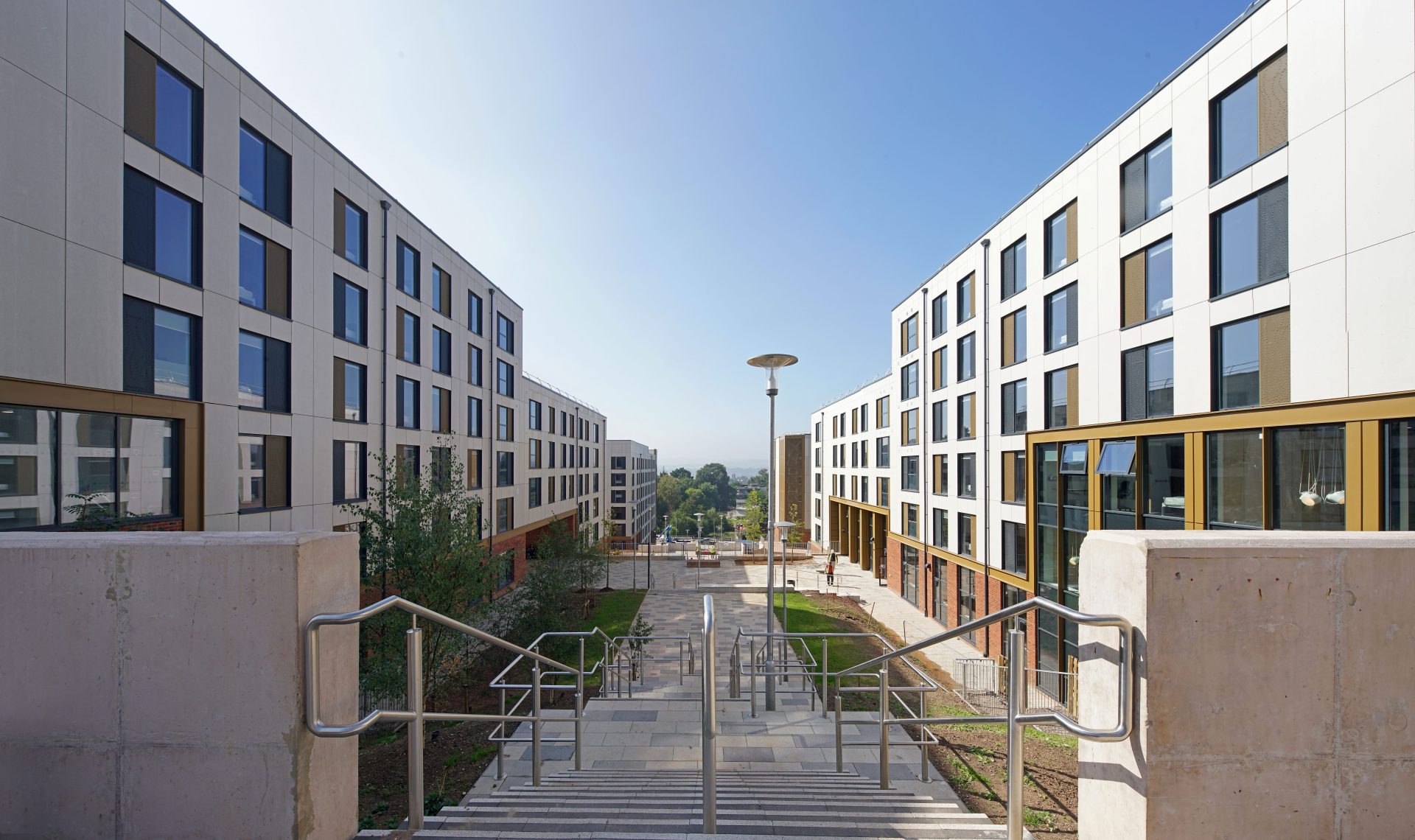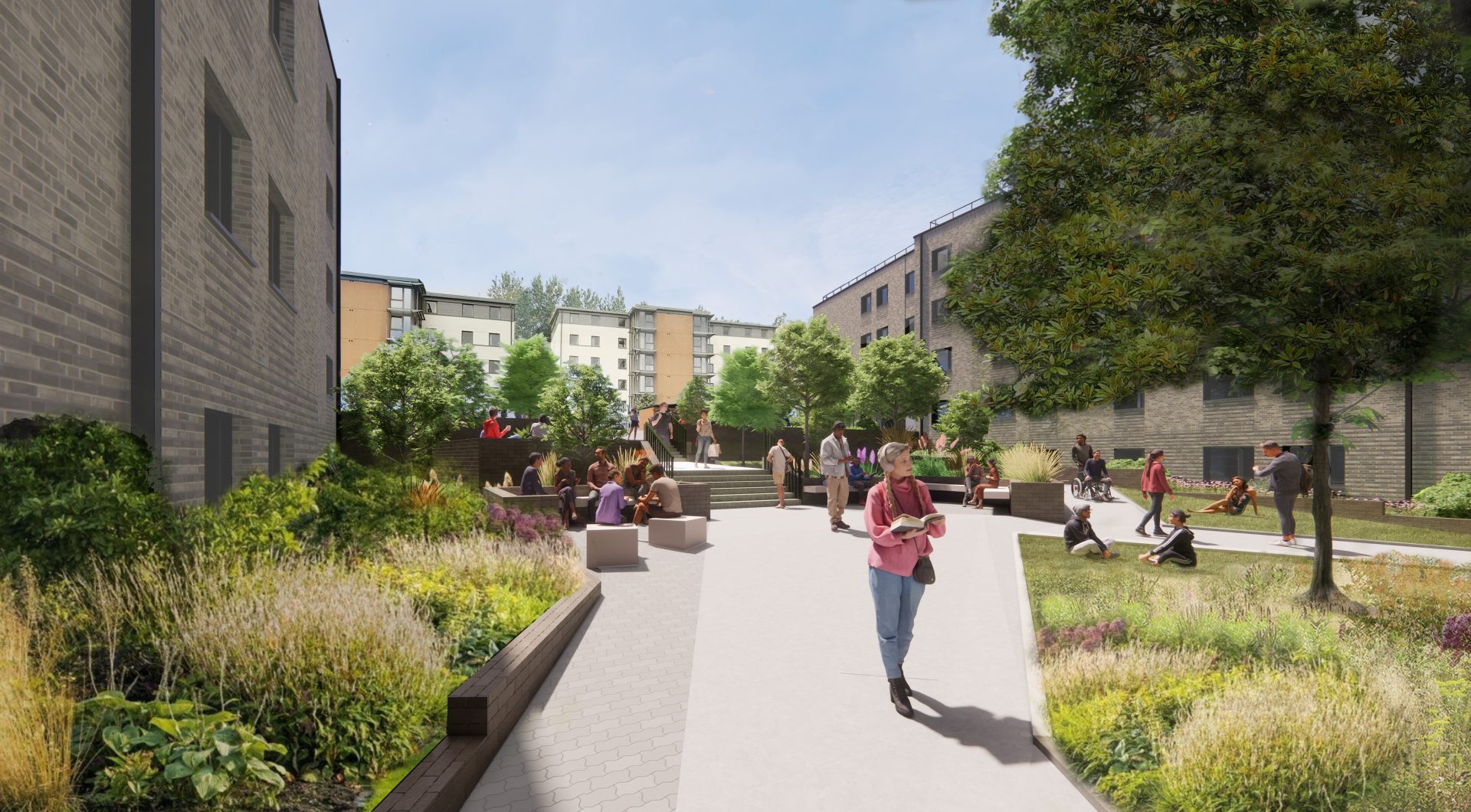Construction Director Adam Tyson reflects on refreshing UPP’s design approach to maximise the sustainability and social contribution that our buildings make.
Adam Tyson is shifting his attention to the future. Fresh from successful completion of the East Park project, a 1,182 bedroom student accommodation development at the University of Exeter, Adam is embracing UPP’s commitment to putting sustainability at the forefront of its design and construction offer to existing and future partners. It’s a “really good opportunity,” Adam says, “to remind people of UPP’s prominence at the head of the campus buildings and services sector, both in terms of our true commitment to long term partnership, our ability to design and deliver schemes successfully and be at the cutting edge of what works best for sustainability.”
Adam is committed to a multi-pronged approach to ensuring the centrality of sustainability to the work UPP does. First, he is ensuring that UPP’s existing best practice, gleaned from design and construction projects being delivered all over the country, is gathered together, made accessible, and continuously updated, with a particular focus on achieving a low carbon result. Second, Adam has conducted a rigorous review and refresh of the architectural expertise that UPP can draw on, to harness the latest innovation in low carbon design.
Cutting edge skills: the example of Passivhaus
Sometimes the process of refreshing knowledge “doesn’t always mean changing the way we do things, but is about checking in and sharing best practice,” Adam says. This can enable the application of skills and experience gained on one type of project to another. For instance, UPP’s own team members, as well as a number of the contractors and consultants that UPP work with, have experience of what are known as Passivhaus certified schemes. These are new buildings designed and built to meet rigorous standards of energy efficiency and sustainability through measures such as increased insulation and carbon-sensitive selection and sourcing of materials. It is a scheme that is of increasing interest to universities who understand its value as part of their commitment to reducing their carbon footprint.
In skills terms, Adam explains, there are two ways we can build on this experience of Passivhaus certification. One involves keeping our skills up-to- date in light of such schemes’ continuous evolution and improvement, by accessing specific training. Another is in applying our collective skills for the benefit of university partners. Some of our contractors’ experience, Adam points out, is of Passivhaus schemes on a smaller scale than university accommodation usually entails, so that UPP’s role is to ensure that “the wider industry lessons learned on things like school buildings are considered, and transferable to a large-scale student accommodation build.”
UPP has the right skills and partners to draw on to enable a university to take the Passivhaus model and make it an accessible option. “We’re keeping at the forefront of that thinking,” Adam says, “so that we, our contractors and designers are the best players to be able to deliver that for our clients.” Continuous improvement is the aim. Gathering UPP’s skills and knowledge together in this way “isn’t about resting on our laurels,” Adam says. Maximising the “lessons learnt” and knowledge sharing processes within UPP and gathering client feedback is about “striving to better ourselves. It is one of the areas that does take a lot of personal energy, but it’s very worthwhile in terms of making sure that we get that positive outcome.”
Towards zero carbon design
Complementary to the prioritisation of sustainable design is Adam’s recent review of the architectural firms with whom UPP works. The aim was to identify particular centres of innovation in achieving sustainable buildings, and assemble a “panel” of firms who could offer the best available expertise, and work alongside UPP at “the forefront of design, construction and delivery,’ Adam explains. “We reached out and spoke to the leading architectural practices, both within the sector and beyond it: those firms who were involved with projects that were particularly interesting to us that we thought we could adapt into our delivery model”. In this sense, the review was a creative opportunity to hear about specific projects, such as a student accommodation scheme in Spain, that may not translate completely into a UK-based UPP project, but which might offer some new approaches that could be adapted to aspects of such a development.
The unifying message coming from the architects Adam spoke to was their commitment to low carbon. “This was at the forefront of their agenda, and rightly so.” The review has enabled UPP to identify the architecture firms who could be the best “fit” for new opportunities to assist our existing and future clients. “If there was an opportunity and the university that we’re working with had a particular set of needs, we can now identify one of those architectural practices to best answer that need.”
Sustainability and responsibility
It’s clear that Adam’s recent work on embedding sustainability within UPP’s design and construction offer is organically related to what he describes as the unique responsibility that UPP takes for its work. UPP is as far as is possible from the outmoded construction company that walks away from a building once it’s complete and shows little interest in the building’s fate or the impact it has on its environment and the community. UPP has a long-term investment, both literal and figurative, in the effectiveness and efficiency of its buildings, backed up by maintenance contracts of as much as fifty years’ duration. It is intrinsic to what UPP does, Adam says, to consider the way its developments enhance wellbeing, both of the environments its buildings occupy and its residents’ mental health.
This, too, was an important part of Adam’s conversations with architects, addressing the need to incorporate mental health considerations into the design of buildings, and to make sure it’s in the DNA of a scheme rather than an afterthought.”
Adam’s recent experience with the East Park student accommodation development at Exeter resonates closely with these concerns. Sustainability was an essential aspect of the development, not least because it set out to achieve, and met, the “excellent” standard according to BREEAM criteria (the world’s leading sustainability assessment method). It also prioritised the natural environment by considering the needs of the site’s wildlife, and creating what Adam calls a “corridor of planting” across the site, connecting it to neighbouring mature woodland.
By considering the wellbeing of its residents in the building’s design and construction, Adam’s team put sustainability at the heart of the East Park project in a broader sense too. In keeping with the priorities of the leading architecture firms he spoke to as part of his work to assemble a “panel” of experts in sustainable architecture, the design of East Park incorporates design features that aim to combat the isolation that many students felt during the pandemic. Bookable social spaces for group activities like yoga and pizza nights as well as generously sized kitchen and dining areas provide opportunities for people to come together. For Adam, “it’s about recognising that there are lots of different personality types, lots of different needs. Some people want to use shared social areas to go out and talk to each other. Others want the ability to have quiet spaces and contemplation away from people. It’s about trying to give due consideration in regards to the design.”
Further testament to the long-term sustainability of East Park was the very high specification cladding that was applied to the building as part of its fire safety measures, pre-empting what is now a wider industry concern in relation to fire issues. “We as a business took an approach with the University,” Adam says, “that we wanted to enhance certain aspects of the scheme to make sure that it was leading the way in terms of current design thinking.”
Thanks to innovations such as Adam’s, expertise in sustainability – in the broadest sense – is central to UPP’s offer to existing and future partners. The approach Adam has taken to embedding expertise in sustainability at the heart of UPP’s design and construction offer also exemplifies the approach of continuous, “iterative improvement” for which he and his team constantly strive. On sustainability, as on other aspects of design and construction, our commitment is clear. As Adam puts it, “We’re a trusted partner who are going to deliver what we say we’re going to deliver.”



























